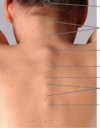Spine Flashcards
(81 cards)
know how these locations dorsal root ganglia, spinal nerves, and peripheral nerves.

what 2 feature of spinal cord form synovial joint to allow movement of spine?
the articular process (up and down)
which vertebrae form the most mobile part of the spine? why?
The Cervical
. -bc o f the curved shape of their bodies>> flexion and extension
-bc of the shallow slope of their oracular surface> later flexion

what r the movement that can can occur in the lumbar spine?
flexion, extension & later flexion to either side.

what r the ligament of the spine

Ligamentum** **flavum
- Yellow in colour: due to “elastic fibres”
- Between laminae of adjacent vertebrae
- Stretched during flexion of the spine
Interspinous ligaments
- Relatively weak sheets of fibrous tissue
- Unite spinous processes along adjacent borders
- Well developed only in the lumbar region (stability in flexion)
- Fuse with supraspinous ligaments
Supraspinous ligaments
- Tips of adjacent spinous processes
- Strong bands of white fibrous tissue
- Lax in extension
- Tight in flexion (mechanical support for vertebral column)

what is ligament flavum?
“yellow ligament” so thick, made of yellowish fibroelastic ligament. (the leastin make sit yellow)
Limits hyper-flexion
important when performing a lumbar punture
Between laminae of adjacent vertebrae

what prevents the vertebrae from slipping away from each other?
the fact their upper articular surface faces upwards and the lower faces downwards, so the lock on each other.

what r the routes of the sciatic nerves?
L4-S3
largest single nerve in the human body

what is Kyphosis?
.

Name and describve the fucntion of structures

Intervertebral disk consists of:
1) annulus fibrosis (onion skin) made of layers (tension resistant sheath)
External fibrous ring that consists of an inner and outer zone
the outer zone is fibrous sheath that gives high tensile strength and made up of concentric LAMELLAE type 2 collagen.
every layer (onion sheet) of collagen lines up in a different way.
In any particular movement we r in, some of these sheets will be in tension and some of these sheets will be relaxed> BUT they will proved a CONSTANT PRESSURE to the nucleus itself.
it transforms compressive forces into tensile forces.
2) nucleus pulpus
gelitinous core,(lots of GAGS) it functions as a “water cushion” to absorb transient axial loads on the disk. 80-85% water
they both act as effective shock absorbers where rhey can distribute pressure uniformaly over the adjacent vertibral end plates.

what is lordosis
.

what is spina bifida?
Spina bifida is part of a group of birth defects called neural tube defects. The neural tube is the embryonic structure that eventually develops into the baby’s brain and spinal cord and the tissues that enclose them.

Describe the pathophysiological processes that result in diminution of height and loss of secondary curvature of the spine in old age?
With increasing age,
annulus fibrosis undergo degeneration (because of wear and tear).
nucleus pulposus loses its turgor and becomes thinner because of dehydration (failure of imbibition) and degeneration.
These degenerative processes account for some loss of height. Disc atrophy returns the curvature of the spine to the primary curvature of the newborn.
State four factors that contribute to the stability and mobility of the vertebral column.
- The thickness and compressibility of the intervertebral discs
- The shape and orientation of the intervertebral facet joints
- The tone of the back muscles
- The resistance of the ligaments of the vertebral column.
Describe the movements of the vertebral column that can occur in each of the cervical, thoracic and lumbar regions. Explain what anatomical features determine the movements possible in each region.
Cervical:
Thoracic:
Lumbar:
Cervical: Rotation only.
Thoracic: Flexion, extension, lateral flexion, rotation.
Lumbar: Flexion, extension, lateral flexion, tiny amount of rotation
What is neurogenic claudication?
.
What is spondylolisthesis? How does it differ from spondylolysis?
.Spondylolysis and spondylolisthesis are common causes of low back pain in young athletes.

Which part of the vertebra is known as the pars interarticularis?

Ligaments of spine

Ok
Describe the 4 stages to a disk herniation
Disc Degeneration: chemical
changes associated with aging
cause discs to dehydrate and
BULGE
• Prolapse: protrusion of the nucleus
pulposus with slight impingement
into the spinal canal (contained)
• Extrusion: nucleus pulposus
breaks through annulus fibrosus,
but remains within the disc space.
• Sequestration: nucleus pulposus
breaks through annulus fibrosus
and separates from the main body
of the disc in the spinal canal.

A 3 year old girl is admitted with fever, tachypnoea (rapid breathing), photophobia, neck stiffness and a non-blanching rash. Meningitis is suspected. A lumbar puncture is performed.
Q1. Suggest a suitable vertebral level at which the needle should be inserted. Explain the rationale for your choice.
Q2. State the structures through which the needle will pass, in order from the skin to the subarachnoid space.
PALPATE THE ILIAC CREST AND BRING UR HANDS TO THE MIDLINE, this equates for the L4,5 disks.
L2/3), L3/4 or L4/5 (after the conus medullaris so only mobile
spinal nerve roots not cord; least chance of neurological damage)
(Skin), subcutaneous tissue, supraspinous ligament, interspinous
ligament, ligamentum flavum, epidural fat and veins, dura mater,
arachnoid mater, (subarachnoid space)

What is spondylolisthesis? How does it differ from spondylolysis?
spondylolysis is defect or stress fracture in the pars interarticularis of the vertebral arch. (spotty the dog’s neck)
Spondylolisthesis is a forward or backward slippage of one vertebra on an adjacent vertebra.

where does the vast majority of spondylosis occur?
The vast majority of cases occur in the lower lumbar vertebrae (L5), but spondylolysis may also occur in the cervical vertebrae.
what has happened here?

Forward slippage of an upper vertebra on a lower vertebra is referred to as anterolisthesis,
(while backward slippage is referred to as retrolisthesis.)




















































